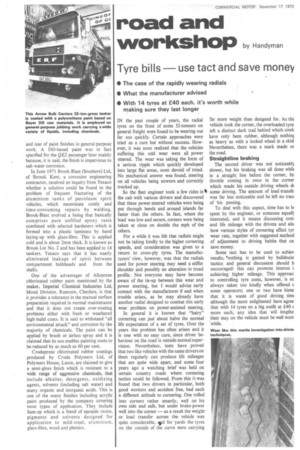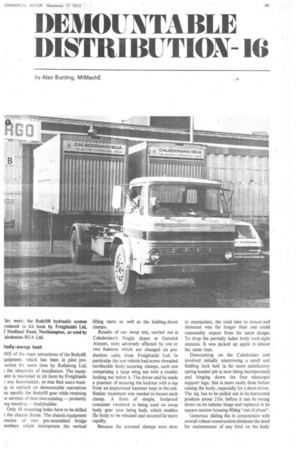road and
Page 104

Page 105

Page 106

If you've noticed an error in this article please click here to report it so we can fix it.
workshop by Handyman
Tyre bills use tact and save money
• The case of the rapidly wearing radials • What the manufacturer advised • • With 14 tyres at £40 each, it's worth while making sure they last longer IN the past couple of years, the radial tyres on the front of some 32-tonners on general freight were found to be wearing out far too quickly. Certain approaches were tried as a cure but without success. However, it was soon realized that the vehicles suffering this odd wear were all power steered. The wear was taking the form of a serious ripple which quickly developed into large flat areas, soon devoid of tread. No mechanical answer was found, steering on all vehicles being unworn and correctly tracked up.
So the fleet engineer took a few rides in% the cab with various drivers and discovered that these power-steered vehicles were being put through bends and around islands far faster than the others. In fact, where the load was low and secure, corners were being taken at close on double the mph of the others.
For a while it was felt that radials might not be taking kindly to the higher cornering speeds, and consideration was given to a return to cross-ply tyres. The manufacturers' view, however, was that the radials used for power steering may need a stiffer shoulder and possibly an alteration in tread profile. Not everyone may have become aware of the tie-up between this wear and power steering, but I would advise early contact with the manufacturer if and when trouble arises, as he may already have another radial designed to combat this early wear problem on power-assisted steering.
In general it is known that "hairy" cornering can just about halve the normal life expectation of a set of tyres. Over the years this problem has often arisen and it is one with no easy cure, since driver behaviour on the road is outside normal supervision. Nevertheless, tests have proved that two like vehicles with the same drivers on them regularly can produce life mileages that are quite wide apart, and some four years ago a watching brief was held on certain country roads where cornering tactics could be followed. From this it was found that two drivers in particular, both good workers and accident free, had each a different attitude to cornering. One rolled into corners rather smartly, well on his own side and safe, but under brake-power well into the corner — as a result the weight or load transfer across the vehicle was quite considerable, ad for yards the tyres on the outside of the curve were carrying far more weight than designed for. As thi: vehicle took the corner, the overloaded tyre: left a distinct dark trail behind which coulc have only been rubber, although nothing as heavy as with a locked wheel in a skid Nevertheless, there was a mark made or the road.
Straightline braking The second driver was not noticeabl3 slower, but his braking was all done whih in a straight line before the corner, hi: throttle coming in once in the corner which made his outside driving wheels d( some driving. The amount of load transfe was far less noticeable and he left no traci of his passing.
To deal with this aspect, time has to IN spent by the engineer, or someone equal!: interested, and it means discussing cost and life mileage with the drivers and als( how various styles of cornering effect tyr wear rate, together with suggested method of adjustment to driving habits that ca save money.
Some tact has to be used to achiev results, 'nothing is gained by bulldozin tactics and general discussion should b encouraged: this can promote interest i achieving higher mileage. This approac: to controlling tyre costs, however, is nc always taken too kindly when offered t some operators; one or two have hinte that it is waste of good driving tim( although the more enlightened have agree that with 14 tyres on a big outfit at £40 c more each, any idea that will lengthe their stay on the vehicle must be well wort while. 'his week: the Bodylift hydraulic system
• roduced in kit form by Freightaids Ltd, f Studland Road, Northampton, as used by aledonian BUA Ltd.
lody-swop test
lNE of the main attractions of the Bodylift quiprnent, which has been in pilot prouction for some time by Rollalong Ltd, the simplicity of installation. The equiptent is marketed in kit form by Freightaids ) any bodybuilder, so that fleet users wantig to embark on demountable operations an specify the Bodylift gear while retaining le services of their own existing — probably mg-standing — bodybuilder.
Only 18 mounting holes have to be drilled the chassis frame. The chassis equipment onsists of two pre-assembled bridge tembers which incorporate the vertical lifting rams as well as the holding-down clamps.
Results of our swop test, carried out at Caledonian's freight depot at Gatwick Airport, were adversely affected by one or two features which are changed on production units from Freightaids Ltd. In particular the test vehicle had screw-threaded turnbuckle body-securing clamps, each one comprising a large wing nut with a smaller locking nut below it. The driver said he made a practice of securing the locknut with a tap from an improvised hammer kept in the cab. Similar treatment was needed to loosen each clamp. A form of simple, foolproof container twistlock is being used on swop body gear now being built, which enables tile body to be released and secured far more rapidly.
Because the screwed clamps were slow to manipulate, the total time to mount and demount was far longer than one could reasonably expect from the latest design. To drop the partially laden body took eight minutes. It was picked up again in almost the same time.
Demounting on the Caledonian unit involved initially unscrewing a small and fiddling lock bolt (a far more satisfactory spring-loaded pin is now being incorporated). and hinging down the four telescopic support legs; this is more easily done before raising the body, especially for a short driver. The leg has to be pulled out in its horizontal Position about 21in. before it can be swung down on its tubular hinge and replaced in its square-section housing 90deg "out of phase".
Generous sliding fits in conjunction with overall robust construction eliminate the need for maintenance of any kind on the body equipment — a feature commented on favourably by Caledonian. It is wise when mounting and demounting not to park the vehicle too close to its neighbour or hard against a wall, although the legs can of course be lowered before shunting into such a confined space. The diagOnal stay for each leg has to be retracted from inside its own tubular hinge, both being stowed within an underfloor cross-member. The stay is secured to the leg through its other function — that of a locking pin, locating in one of a series of holes, providing different leg lengths on varying heights of chassis — an especially valuable feature when considering split trunking movements using rigids and normal height semi-trailers.
Obviously the locking pin-cum-stay cannot be positioned until the body is raised. This entails connecting the control panel, which is a hand-held box normally kept in the cab for security reasons. There are two trailer-type lighting plugs to be connected, one from the electrical supply on the chassis (wired through a master switch), and one into the power-pack mounted on the nearside of the frame.
When the control panel — on an 8ft lead — has been connected, "front" or "rear" is selected and by means of a simple push button each pair of rams is raised in turn. There is 14in. of ram travel available, which caters for the softest vehicle springs and the roughest ground normally encountered.
As the body is lifted, its support legs extend telescopically under their own weight. On level ground the driver knows in which of the six location holes to secure the stay/pin, and therefore how far the body needs to be raised at each end. The rams are wide enough apart for the body to be supported on all four during the lifting operation, without risk of instability in a side wind. It is therefore unnecessary, as on some demountables, to raise the body and secure the legs at one end before beginning to lift the other end. At the same time the rams themselves are unusually sturdy, and have passed a rigorous British Standard structural test — particularly significant in view of the side-loadings imposed during bodychassis alignment.
Picking up the body involves backing the chassis until contact is made with a pair of ' tall, upright stays behind the cab. The driver's skill and experience is relied upon to ensure that the ram-heads are positioned immediately below the four dished lifting pads in the body floor structure. On the Caledonian vehicle, the "dishes" were too small in diameter and too shallow to centralize the ram-heads effectively. Later units have 8in.-diameter dishes able to align any body which has been backed between. the rear legs and kept parallel. Final alignment comes from the contact of veeshaped saddles adjacent to each lifting point.
Service experience Caledonian has three Ford D800 chassis equipped with Bodylift lifting gear. They• work with four 21ft 6in. boxvan bodies, plying mainly between Gatwick and Heathrow airports, carrying air-freight. The need to meet flight departure times calls for a high standard of reliability. Mr John Dear, transport manager for all Caledonian's surface vehicles worldwide, told me the Bodylift equipment had proved 100 per cent reliable in over 24 years' operation. He felt that while it might lack the sophistication of some other systems it had stood up better to the ruthless 24hr every-day-exceptChristmas punishment of air-freight moving. The particular features where it had scored included the strength of the support legs and the length of ram travel on uneven surfaces.
Mr Dear was less enthusiastic about the time needed to release and secure the holding-down clamps, saying that he would welcome quick-operating twistlocks in their place.
Although the van bodies are equipped with Joloda pallet-loading equipment it was not always feasible to load a waiting vehicle as quickly as the turnround time of a demountable.
Interchangeable with the van bodies are two flat platforms, which allow the D800s to be used for carrying airliner engines between Caledonian's Gatwick base and, for example, the Rolls-Royce overhaul depot at East Kilbride in Scotland.
Caledonian's demountable chassis are each clocking about 100,000 miles a year, in the hands of a mixed bag of drivers, all of whom are nominally conversant with the body-swopping procedure.
































































































































































